|
FAQs about Zoanthid Health, Pests, Predators
4
FAQs on Zoanthid Disease:
Zoanthid Health, Pests, Predator 1,
Zoanthid Health, Pests Predators 2,
Zoanthid Health, Pests, Predators 3,
Zoanthid Hlth., Pests, Pred.s 5,
Zoanthid Hlth., Pests, Pred.s
6, Zoanthid Hlth., Pests,
Pred.s 7,
FAQs on Zoanthid Disease by Category:
Diagnosis,
Environmental,
(Pollution/Poisoning,
Lighting...), Nutritional,
Social (Allelopathy),
Trauma,
Pathogenic (Infectious, Parasitic, Viral)
Predatory/Pest,
Treatments
& Zoanthid
Reproduction/Propagation,
Related Articles: Zoanthids, Sea Mat: An
Ocean Of Color For The Aquarium by Blane Perun,
Related FAQs: Zoanthids, Zoanthids 2, Zoanthids 3, Zoanthid ID, Zoanthid Behavior, Zoanthid Compatibility, Zoanthid Selection, Zoanthid System, Zoanthid Lighting, Zoanthid Feeding, Zoanthid Reproduction,
|
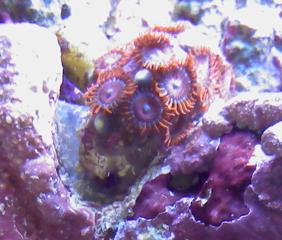
|
|
All my Zoanthids are closed! 2/28/10
Hi,
<Howdy>
Having searched all through WWM and other forums for help with my
problem, I have had no success. All of the Zoanthids in my system
are closed, and the have been for over 3 months.
<Summat's up>
I have done a hydrogen peroxide dip and a freshwater dip on all
of them (I have about 6 different kinds...) over about the past
month or so and there is still no change. The hydrogen peroxide
dip did seem to get rid of some fungus
<?>
on some of them, but the freshwater dip cleaned off nothing but a
few small pods and some snails (not sundial though). I have
looked at all times of the day and night and have yet to find one
Zoanthid spider, sundial snail, or Nudibranch on any one of my
colonies. Also, the Zoanthids are not 'melting away', and
some of them still look very plump.
My system is very small, 10g with a 5g refugium of Chaeto. I know
there might be a problem with allelopathy among the
Zoanthids,
<Ah yes... likely in/with such a small volume
especially>
but wouldn't one of the colonies be thriving while the others
are closed off?
<Mmm, nope. All could be, are apparently
"losing">
Also, there is only a crocea clam, and two small xenia and clove
polyp frags <Either one of these could be
"winners">
in there with them, each of which is thriving. There is only one
fish in there right now, a yellow watchman,
<Needs more room than this>
and some Turbos and Astreas. The only other thing I can think of
is that my lights may be old, I am running a 70w MH unit about 8
inches above the water and the bulb is about 8 months old... it
is a good bulb though and like I said this has been going on for
months so I doubt this is it. My water parameters are good,
too:
SG 1.024
<S/b higher. See WWM>
Ammonia 0
Nitrite 0
Nitrate 0
<An essential nutrient. Could be the trouble here>
Phosphate 0
<Ditto. Remove, reduce your chemical filtration, increase
feeding>
Ca 1350
<Mmm, no>
dKH 9-10
Mg 1525 (I know a bit high... but I doubt this would do it?)
<Yes, could>
Temp: 78-81
Lighting: 70W MH for 7hrs, actinic 2x18W 9 hrs
Flow: 2 90gph pumps, 1 Koralia Nano
I also have My tank has been up and running for over two years
now and I have been able to keep Zoanthids fine until about 3-4
months ago. Attached are some photos of my closed colonies. I am
at my wits end and ready to throw my tank out. I know Zoanthids
can be finicky, but I would think at least one or two colonies
should open. Any ideas?
<... fix your water quality first, do what is necessary to
provide some NO3, HPO4... Move the colonies elsewhere... Bob
Fenner>
|
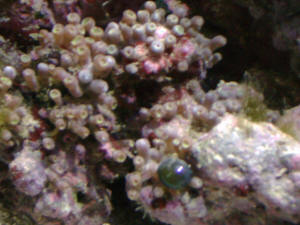 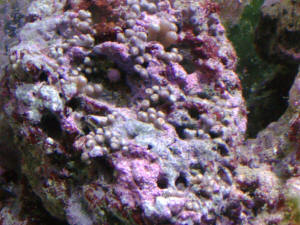 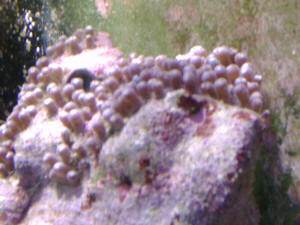 |
|
Re: All my Zoanthids are closed!
2/28/10
Thanks for the quick reply. I think I will move the bigger
colonies to the LFS and be content with Xenia/clove
polyp/clam...
<Ahh>
leave one or two small Zoa frags, and try to get the water
quality right.
<Good>
The problem with Nitrate and Phosphate is that even when I feed a
lot they are still undetectable, I assume due to my Chaeto in my
"refugium" which grows quickly.
<I would keep harvesting this Green Algae; to the extent where
there is some measurable essential nutrients here>
However they must be in there somewhat because I still have
significant green hair algae.
<Oh! Then address this first. See WWM...>
Could it be a problem with ph/alkalinity swings?
<Yes>
I add Kent Superbuffer regularly
<S/b only done through additions to pre-mixed, stored new
water during change-outs>
but there could still be swings and this I have heard to affect
Zoanthids. Or are you pretty sure it is allelopathy?
<Can't discern from here>
I am pretty resigned to the fact that this is it. Again thanks a
lot for the service.
<Certainly welcome. BobF>
|
|
Hungry beast in my tank; makes translucent tubes,
burrows holes in live rock, and eats Zoas and candy canes!!
2/19/10
Hello WWM Crew!!
<Bruce>
First of all please let me thank you for all you do and for all
the help you have provided me in learning how to keep a reef!!
You time is appreciated by me!
<We share!>
Secondly, I am sorry to bother you but I cannot find previous
posts that show pictures of what I have. Any help you can provide
me will be greatly appreciated.
I have not been able to identify the villain(s?) I am battling in
my tank.
Here is what I know about said villain:
* builds calcium tubes about 1/8 inch diameter
* makes translucent 'tents'
* dines on Zoas.
* dines on candy canes
<The Nudibranch in your first attached file? Oh yes>
My piece-O-reef is a 20 month old system that is comprised of a
120 display and a 50 gallon fuge. Both display and fuge have a
5" DSB of large grain aragonite with a plenum. Mostly LPS
with one piece of healthy SPS.
Around Feb 7th, I noticed enough issues with my Zoas that I
decided to take action; my problem is receding Zoas and, many
months before that, physical damage (white puffy tubes or
tunnels) to a couple of my candy canes. Long ago I moved the
candy canes and had not seen the translucent tubes in months. Now
they are appearing again near a Zoa frag on the same rock.
<These tubes shouldn't be problematical. Are they
illustrated here?>
Two weeks ago I pulled a lone Nudibranch out of my fuge.
http://www.box.net/shared/xmy1x8y10q
<This is a predator...>
Also, upon further investigation of other Zoas in the tank I
noticed what I could best identify as Zoa pox (Zoas that would
not open and showed white spots around some of them) on about 15%
of the Zoas in my display. From looking around it seemed like a
fresh water dip in a 7 drop per gallon mix of Lugol's water
then a Seachem coral dip was the best course of action.
<Yes, but...>
The problem is that I removed all coral but one for treatment. I
left one frag of Zoas in the display (showed no signs of
problems); yep you guessed it now that frag is receding and
showing the tubes and now a 'tent'. You will notice the
'tent' to the left (lower half) of the frag plug.
<I can't quite make this out>
(also note the hole or 'door' at the bottom of the frag
plug)
<Nor this really>
I can remove the last frag but I assume the critter is in the
live rock and don't want to give him a chance to hide away to
haunt me another day! Do I dip the live rock and kill everything
on it? seems a bit like a bull in a china shop approach to
controlling the little bugger.
<Which? Sorry for my confusion. Are you referring to the
Nudibranch/s?
These are best removed via siphoning... the "tents" and
tubes by physical scrubbing (outside the tank)>
On the 14th I noticed an update; 80% of the 'tent' was
gone and by Sunday morning the remainder is gone. The Zoas were
still in their receded state with no visible signs of external
munching or other physical removal just a slow but steady
retreat.
<There's something else going on here highly likely...
some sort of interaction twixt your other Cnidarian life perhaps.
Ideally, after such "processing", the Zoanthids
can/will be placed in a system of all new seawater>
Other frags (on the frag rack on the wall) are fairing fine in
the tank, three types of Acans, Favia, Galaxea un-named SPS. The
Zoas on the frag rack (Mohawks and some other no-named frags)
show mixed results. I report them as 'mixed' results
because the Mohawk are wonderful but the others seem to be
enduring light shock (due to moving the frag rack around the tank
while tearing out the corals on the live rock).
I also set up my 'night-vision' camcorder to see if I
could catch any critter feasting on Zoas, no luck but boy o boy
do I ever have more 'pod' action than I imagined!!
The link to some of the night shot of the affected Zoas:
http://www.4shared.com/dir/31193171/45f3ce9a/sharing.html
<Neat>
And finally tonight I hate to say it but at this point the Zoas
are almost gone. I tired to take another picture to see if I
could get a better shot of the tubes.
http://www.box.net/shared/ne6aih85d9
To the right of the frag plug just above the middle you can
almost make out a translucent tube. The tube extends down between
the rock and frag plug.
Also, you can barely make it out but there seems to be
"chewed" or "powdered" calcium looking stuff
below the lowest edge of the plug. The tubes appear to be able to
go into the live rock so I am guessing that the critter can
'burrow'.
<... I have tried to manipulate this image... and still
can't see what you are referring to. Sorry>
Please help me identify this beast and point me to the
remedy.
Thank You!!!!!!!!!!
< I wish I could offer you more here. I would not add
more/Zoanthids to this system. I would vacuum, remove the
Nudibranchs, their egg casings. Bob Fenner>
|
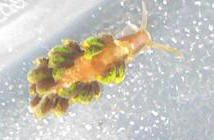   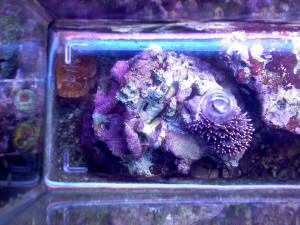 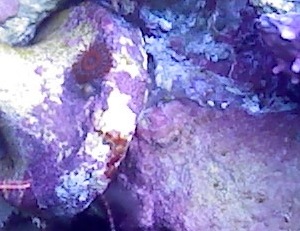 |
Zoo Colony - All Closed Up 2/4/2010
Crew,
<John>
I've got a zoo colony (around 45 individuals) that has been closed
up for the last 4 days. Well, 1-5 individuals will be open at any one
time, but not the whole colony open as it has been for the last 1.5
months (4 weeks in QT & 2 weeks in display). The ones that are open
seem to alternate from day to day and there seems to be no damage
to
any of the tissue or color change. The zoo color when closed is
unchanged from day 1 too, so I think they're fine in that respect
(i.e. not dying). I'm concerned about them remaining closed in the
long term to lack of feeding activity.
<I see>
I have a 120 gal display with a 150 gal refugium/sump (split down the
middle).
<Nice>
Around 180 lbs of live rock in display & 80 lbs in the refugium.
560 watts PC and 1,200gph water turn-over. I run Aqua C EV180 skimmer,
UV, Ozone, calc reactor and all water param.s are good (8.24 ph, 1.025
salinity, 10-11 dKH, 78.5 temp, less than 10ppm nitrates, RO water and
regular supplements. I haven't measured calc or Mag in a little
while, but all other inhabitants fully extended, open, active, etc.
(I'll get to those later).
The Zoanthids were the last addition to my tank --
<Ahh, what other Cnidarian life is present?>
no changes since the zoo went to QT in livestock, equipment, etc. (just
routine maintenance). The Zoanthids are 10' from the surface and
8' from the nearest inhabitant. I did notice some very small snails
in the rock with the Zoanthids in qt, but they didn't seem to be
bothering them in there.
<Mmm, I would have excluded them/these>
They were very small (similar to pod size) -- had a small oval shell
with very long antennae in relation to their body. The shell was so
small; I actually thought they were some type of sea slug or Nudibranch
at first glance.
<Even potentially worse>
My own personal diagnosis at this point is chemical warfare.
<Is a possibility>
No changes like introduction of livestock, bulb replacement, water
change, flow direction change, etc., but something clearly happened 4
days ago to cause them to all close. Accumulation of chemicals until it
reached 'x' level 4 days ago is all I can assume at this
point.
I have 3 rose bta's (1 that's split a couple times & the
prime suspect), frogspawn (the closest inhabitant to Zoanthid 8'
away), scrolling plate coral, several xenia, 2 colts, 3 polyp colonies
and several reef safe fish. The bta's are my suspect #1 --
<Actually, I'd give top mark to the Euphyllia>
they're all 14+ inches away, but I know they doesn't mean too
much. 2 have moved slightly, but nothing significant as far as contact
with anything else, but I assume this too could indicate some agitation
I guess.
Here's what I've done in the last 2 days -- 40 gal water
change, cleaned out skimmer & added charcoal into a fluidized media
bed.
Water changes and skimmer cleaning I do regularly. I don't normally
run charcoal/carbon. Would you recommend any other actions or
suggestions?
<Mmm, possibly... move the Zoanthid colony elsewhere... back to the
quarantine... Re-introduce slowly through water exchanges twixt the QT
and DT>
I'm heading out of town for the week on Sat, so I want to make any
changes asap. The house sitter will/can only do feedings.
Thanks,
John
<And read here when you have time:
http://wetwebmedia.com/cnidcompppt.htm
and: http://wetwebmedia.com/zoanthidcompfaqs.htm
and the linked files where you lead yourself. Bob Fenner>
|
Snails: Likely Collonista Snails, Issues with
Disappearing Zoanthids -- 1/6/10
<Hello Tommy, Lynn here today.>
Help, I'm trying to ID this snail.
<Yay, I love snail ID's!>
I'm hoping it's not a Heliacus.
<I think you're in the clear. It looks like a common,
harmless, herbivorous hitchhiker in the genus Collonista,
sometimes called a 'Mini Turbo' snail. To positively
confirm, use a magnifying glass and take a good look at the
snail's operculum (the 'trap door' at the opening of
the snail). You should see a tiny pit/hole in the center. If you
don't see one, do try to get a few detailed photos and
we'll try again. Just for comparison, Heliacus spp. (aka
'Sundial') snails tend to be rather squat top to bottom,
with straighter sides, a rather heavy, almost 'beaded'
appearance to the surface, and an obvious cone-shaped operculum.
For more information/photos re: Collonista snails, please see the
related FAQ's at the following link:
http://www.wetwebmedia.com/snailidf14.htm
More here:
http://bb.wetwebmedia.com/viewtopic.php?f=25&t=242
Here's an example of Heliacus spp. snails:
http://www.gastropods.com/5/Shell_5765.shtml >
My zoo's are disappearing fast
<Uh-oh. If the water parameters/conditions and other livestock
are okay, then I'd look for either some sort of predator or
irritator, or evidence of disease. The list of potential
predators and irritators is long and includes Heliacus snails,
Pycnogonid spiders ('sea spiders'), Gammaridean
Amphipods, Vermetid Gastropods, Nudibranchs, a few crabs, various
fishes (Angels, Tangs etc.), tube dwelling Polychaetes, etc.(see
links below for photos). Your best chance of spotting some of the
smaller, and/or more cryptic individuals is at night with a
flashlight. If you're able to rule out pests, I'd look
into possible disease (pox, fungus, etc.). Take a good look at
the colony, especially the stems. Are there any light or whitish
spots present? Do the stems look fuzzy, spindly or unusually
dark? Once you determine what the problem is, please use our
Google search engine for a solution/treatment:
http://www.wetwebmedia.com/Googlesearch.htm
In the meantime, we have lots of information regarding Zoanthid
problems, starting here:
http://www.wetwebmedia.com/zoanthidhlthfaqs.htm
Check out this link for some terrific photos of Zoanthid
predators, irritators and pox:
http://zoaid.com/index.php? module=Gallery2&g2_itemId=384
>
..and I'm noticing that these snails are multiplying very
fast.
<Collonista snails can indeed multiply quickly, but don't
usually cause problems.>
These are the best pictures I could get.
<I think we're good to go with this snail. However, as per
above, if you find that what you have isn't a Collonista,
then do please let me know.>
Thanks for the help!
<You're very welcome!>
Tommy
<Take care, LynnZ>
~^~^~^~^~^~^~^~^~
| <°)))>< <°)))><
| <°)))>< <°)))><
¸¸.·´¯`·..
><((((º>`·.¸¸.·´
><((((º>`·.¸¸.·´¯`·.¸.·´¯`·...¸><((((º>¸¸.·´¯`·.¸.
`·..
><((((º>`·.¸¸.·´¯`·.¸><((((º>¸¸.·´¯`·.¸<°)))><
.¯`·.¸><((((º>
|
|
¿ >°)))><
|
 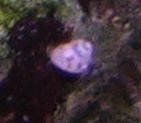 |
|
Re: Snails: Likely Collonista Snails, Issues with
Disappearing Zoanthids -- 1/7/10
<Hello Tommy, Lynn here again.>
Thanks for all of the help!
<You're welcome!>
I think it must be the asthenia snails
<You mean Asterina stars?>
..doing the damage. I guess I will get a harlequin shrimp to
combat these.
<I wouldn't, unless you're absolutely overrun with the
little stars. Otherwise, once they exhaust the food supply (of
stars), they'll likely starve to death. I would instead opt
for physical removal (tweezers work well). Please see the
following links for more info re:
http://www.wetwebmedia.com/harlshrpfaqs.htm
http://www.wetwebmedia.com/asterinafaqs.htm >
I will have to get rid of my sand star first though.
<It's possible that the star could escape the shrimp under
the sand, but I wouldn't chance it.>
I have attached a couple of pictures one is before and then you
can see what happened. The other is what the fire and ice look
like and it used to be full.
<Yikes!>
Again Thanks for the help!
<It was a pleasure! Take care, LynnZ>
|
Palythoa trouble 12/23/09
Just recently got some frags in of some high end Zoanthids and
Palythoas.
One frag which was of a very expensive Paly had the coral detach from
the plug during shipping and appears to be banged up. Once it was in my
tank and it opened it appears to have expunged it's stomach
contents. Half a day
later the contents are still sitting on its mouth, I haven't wanted
to try and blow it off or anything for fear of agitating it further and
making things worse.
<Good>
The rim colors of the Paly appear to be normal and it IS open but
I'm wondering whether it's likely to pull through.
<Zoanthids are very tough animals...>
Also if whatever it has done results in color loss around the mouth,
will that color likely eventually return or as it begins to propagate
will the new polyps have the original coloration?
<Likely to return to colour given propitious circumstances,
nutrition>
Thanks again, you guys are awesome!
Adam
<Mmm, read here: http://wetwebmedia.com/CnidIndex2.htm
the first tray at top... re Zoanthids. Bob Fenner>
|
|

